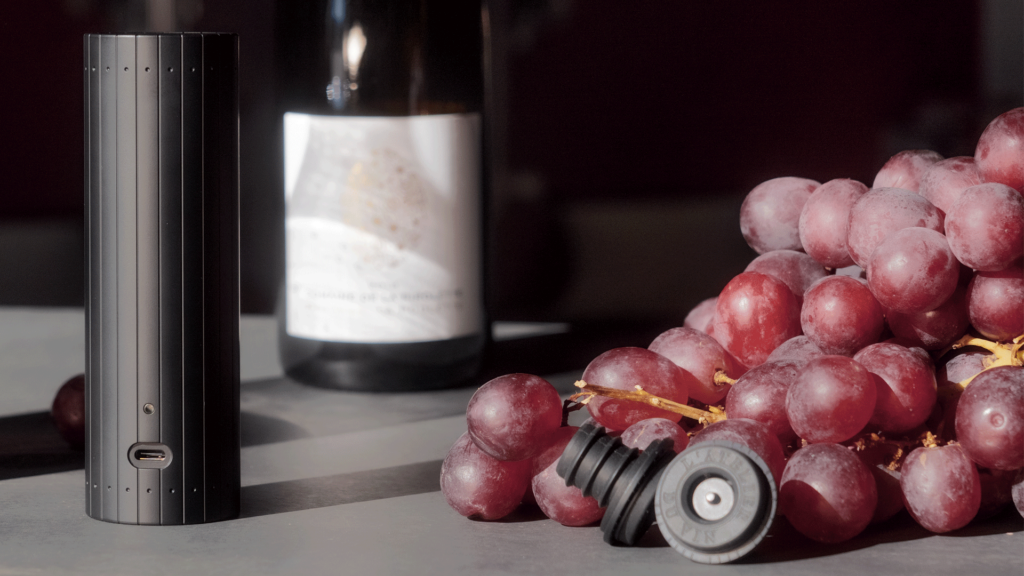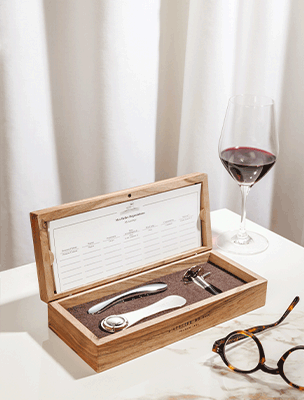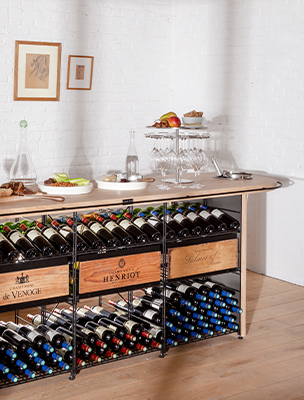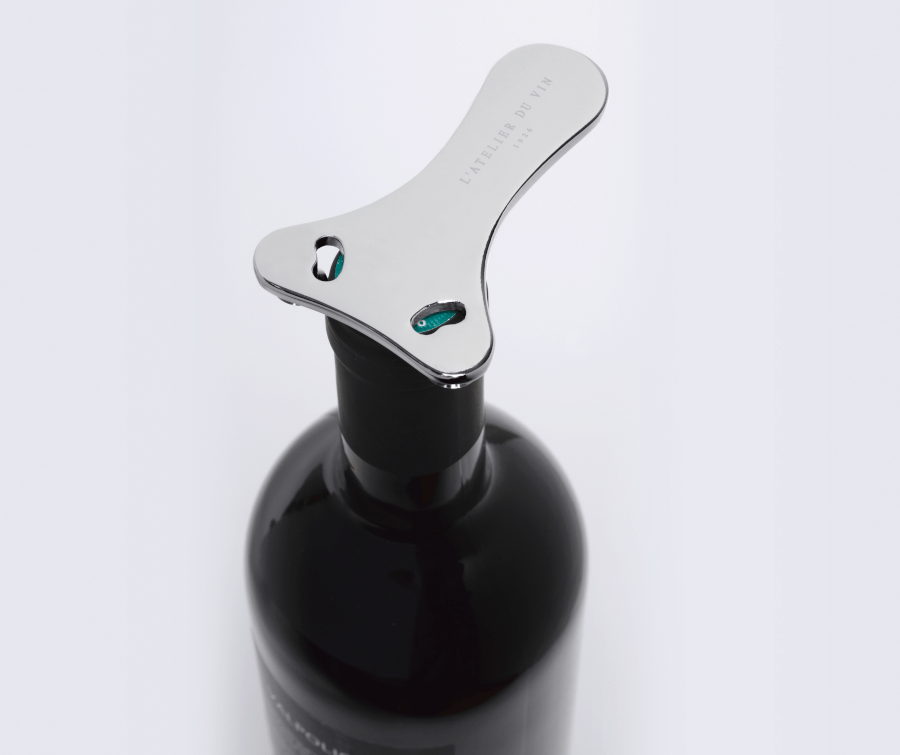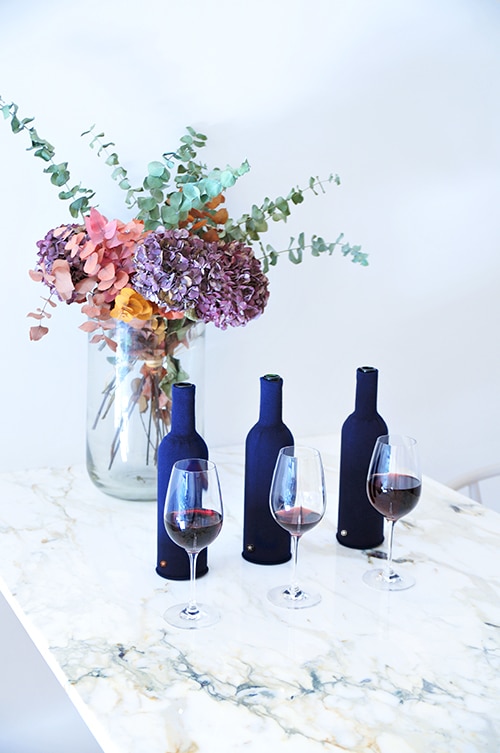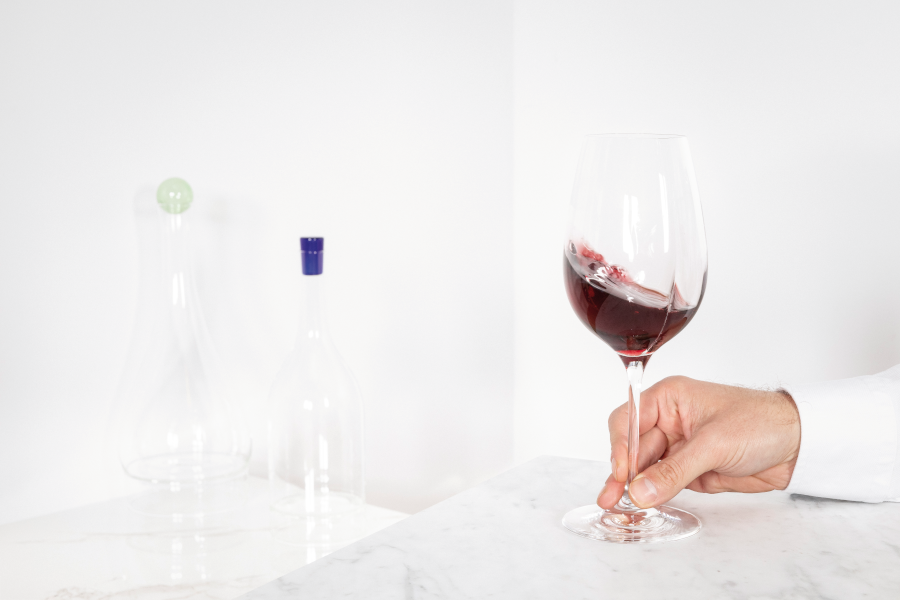
From the wine cellar to the table, serving wine is an art. Those familiar with the secrets of oenology know the subtle nuances of each step—from making the necessary preparations when taking the wine out of the wine cellar and opening the bottle correctly to decanting and aerating the wine if necessary, before serving it in real wine glasses.
A summary of our guide to serving wine:
- Preparations
- Opening the bottle
- Decanting and aerating wine
- Serving wine
- Storing a wine after serving
Why do you have to take so many precautions when you want to serve a bottle of wine?
In the art of oenology, no detail is left to chance. If you rush through the steps or lack knowledge of the proper processes, you could leave a beautiful bottle of wine unfit for consumption. Fortunately, learning how to serve wine is as fun as it is useful.
What’s more, carefully executing the steps of the oenological ritual with the right wine tools will give your wine tasting experience that extra soulfulness and make the pleasure even more intense—giving that special moment shared with guests a truly authentic touch.
Explore the friendly, intimate world of L’Atelier du Vin and discover our guide to the best wine serving practices to find out what accessories to use for preparing, opening, decanting, aerating and serving a wine—whether you are serving red wine, white wine or champagne.
What should you do to prepare a wine before serving it?
To make sure you are serving your wine properly, you must first meet certain conditions before opening and sampling any bottles. You’ll be sure to wow your guests if you choose the right wines to pair with the different courses on your menu. You should also try to ensure a smooth transition from the cool environment of the wine cellar to the warmth of the room in which you plan to taste your wine, by gradually bringing the wine to the right temperature for serving.
Choose the right wines to accompany your food and the season
The perfect wine tasting starts with choosing the right vintage for the occasion. At the dining table, your wine should go perfectly with your starter, main, cheese course and dessert. The pairing should feel so natural and pleasant to the palate that it makes you want to help yourself to more, with almost childlike indulgence.
If you are looking for inspiration or reassurance about a new pairing, take a look at our detailed guide Wines and Meals for the 4 Seasons, carefully put together by David Cobbold and Sébastien Durand-Viel. Many other useful and fun resources are available from L’Atelier du Vin to help you fine-tune your knowledge of wine and the art of oenology!
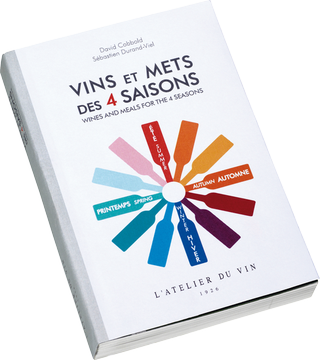
Ensure a smooth transition out of the wine cellar
Once your wine list is ready, it’s time to retrieve your bottles! If the vintage in question is resting quietly in your wine cellar, don’t rush and take it out too abruptly to taste it. Take care not to shake the bottle and if it is lying horizontally, gently lift it to stand it in an upright position.
Wines are very sensitive to changes in temperature, light and their surroundings, and this is especially true for bottles that have aged for many years in the calm environment of a wine cellar. Let your wine wake up gently as it rests in an upright position, without moving it for at least a few hours—as long as 12 to 24 hours before tasting. This will allow any sediments still suspended in the wine to fall and settle at the bottom of the bottle, where they should stay.
Serve your wine at the right temperature
To ensure you provide the most enjoyable tasting experience possible, your precious nectar should not be served at too cold or, more importantly, too warm a temperature. If you are unsure of the recommended temperatures for serving wine, here is our handy guide to the correct temperatures to serve white, red and rosé wines, and champagnes:
- sweet white wines: 6 to 8 °C
- fruity, acidic and light dry white wines: 8 to 10 °C
- complex and rich white wines: 11 to 13 °C
- fruity and light red wines: 11 to 12 °C
- red wines with medium or high alcohol content: 14 to 16 °C
- tannic red wines: 16 to 17 °C
- the finest grand cru red wines aged to maturity: 17 to 18 °C
- fruity and acidic rosé wines: 8 to 10 °C
- well-rounded and full-bodied rosé wines: 10 to 12 °C
- champagnes and sparkling wines: 8 to 10 °C
Is your wine still a little too cool? Let it warm up in your living room, where it can be left to breathe at room temperature—for example, in a decanter (if aeration is suitable for the vintage in question). Also, if you hold the bottle in your hands, the temperature will rise by a few degrees in just a few minutes.
How should you open a bottle of wine?
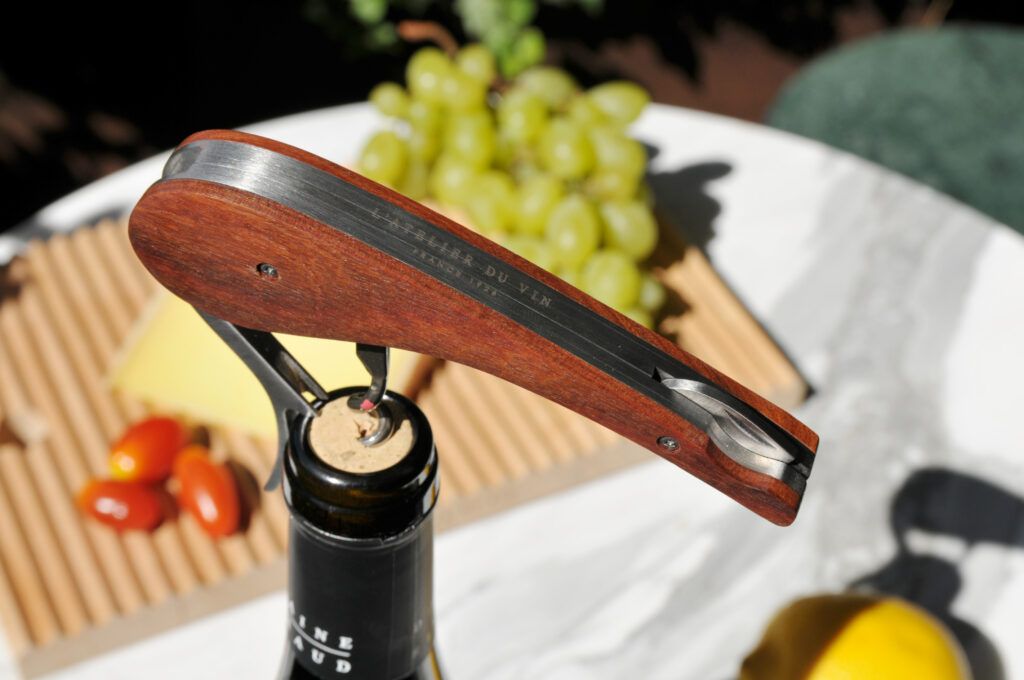
After carrying out the necessary preparations, the wine serving ritual really kicks off in the sacred moment that you open the bottle under the eager gaze of your guests. This essential step marks the beginning of the ceremony, which is why it must be perfectly mastered. Once again, take your time—don’t rush this step! Examine the type of cork that is in the bottle and see how worn and fragile it is to work out which type of corkscrew is the most suitable.
Neatly remove the foil
First of all, a foil cutter is ideal for cutting the foil in a clean and precise way before opening the bottle. If you are using a blade instead of a foil cutter, you should cut along the outer lip that goes around the neck of the bottle. Once the foil has been removed, wipe the top of the bottle with a clean cloth to remove any dust (which could inadvertently mix with the wine when you pour the first drops).
Use the right corkscrew for the task
Choosing the right corkscrew depends on the type of bottle you are going to open and the setting in which it will be tasted. It is also a matter of personal choice, a mark of your signature style as a sommelier. Among the different mechanisms that can be used to open a bottle of wine, choose the one that best represents your story and personality, as it will remain one of your most important tools as a master of ceremonies celebrating the nectar of the gods.
Wine enthusiasts strive to collect all the different types of wine openers and have one of each ready in their specialist toolkit so that they can mix things up and handle any situation. Whatever your wine tool of choice, it is essential not to damage the cork when opening the bottle—if a few crumbs of cork fall into your wine, you won’t be able to drink it!
If you are opening a relatively young bottle, you can use a variety of corkscrews, as long as there isn’t a problem with the cork. You can use a waiter’s wine key or corkscrew, a wing corkscrew, a basic corkscrew, an endless worm or an electric wine opener, among other models. On the other hand, if you are opening an older bottle or a fragile cork, proceed with caution and use a specialist lever corkscrew or a two-prong wine opener. The latter slips between the glass wall of the bottle and the cork, allowing you to open the bottle without damaging the cork and even reinsert it after you have finished your wine tasting! To find out more, you can consult our guide to using wine openers and corkscrews.
Check the wine’s temperature and sample it
When you have just opened your bottle of wine, you can make the most of the opportunity to glean some valuable information about its contents and check the wine’s temperature. You can find out the exact temperature of your wine with a wine thermometer to see if it is too cool, or not cool enough. You can also sample the wine—not for lack of patience, even if it feels indulgent—to find out if it needs to be decanted and aerated. It’s a step that is often overlooked, but this reflex can save your wine tasting before the wine is served.

Should you decant and aerate a wine before serving?
After opening a bottle of wine, should you decant and aerate the contents? While this step in the process is crucial to the wine tasting experience, many false rumors and bad practices surround the subject. First and foremost, it’s important to remember that decanting wine is not the same thing as aerating wine, even though they can be part of the same part of the process. Secondly, don’t forget that not all wines should be decanted, which is why it is important to know when to decant and aerate wine and when not to. For a summary of the essentials, here is a short guide to decanting and aerating wines.
- Fruity wines: decanting the wine is optional.
- Young wines: aerate the wine by pouring it into a wide-bottomed wine decanter for better oxygenation—this will allow the wine’s body to take shape, giving it the air it needs to fully express its character.
- Rich and complex wines: decant the wine and let it aerate for a few hours so that the aromas of its bouquet can emerge and develop.
- Older wines: if necessary, decant your wine very delicately into a narrow decanter just before serving to eliminate the sediment from the wine, without disturbing the fragile balance of its aromatic structure; if the decanting process is too risky for your vintage, serve it very gently from the bottle, keeping the sediment as far away as possible from the neck of the bottle.
Decanting wine
In the original sense of the word, the act of decanting a wine means separating the sediment that has formed in a bottle over time. If you examine your bottle in daylight or candlelight, you will be able to see if any sediment is suspended in the wine, which is more often the case with older vintages.
To separate your wine from the sediment that has formed in the bottle and do justice to your vintage, nothing beats an elegant wine decanter. Pour the nectar of the gods delicately into the decanter, making sure that the sediment doesn’t come too close to the neck of the bottle. While pouring the wine into the decanter, you can use a pourer to make sure you don’t lose any wine along the way.
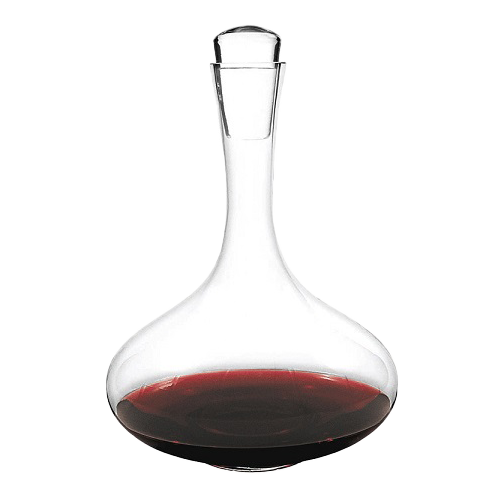
Lastly, it is important to remember that some wines are too old and fragile to be decanted without damaging them. In this case, you should let the bottle stand upright for a long period of time to allow the sediment to fall and settle at the bottom of the bottle, then pour the wine very slowly into your wine glasses without letting any of the sediment pass through the neck of the bottle. A “drop-stopping” pourer will provide you with a little extra safety margin.
Aerating wine
Aerating a wine means letting it breathe by increasing the surface area that is in contact with the air. This can also be achieved by using a wine decanter, which is why it is often confused with the decanting process. As a general rule, young, robust and well-structured wines benefit from being aerated. The oxygenation process reveals the aromas of a wine’s bouquet, letting the wine develop a stable, interesting and consistent character as a whole. In contrast, older and more fragile wines should not be aerated, or only very slightly, as they can become oxidized and lose their structure, which can prove fatal to your appreciation of the wine.
- To aerate a young, sediment-free wine, pour it generously into a wide-bottomed decanter, holding the bottle vertically to give the wine an extra boost. Feel free to swirl the wine in the decanter to oxygenate it before serving.
- To aerate a more mature wine, start gently by letting it catch its breath in its open bottle and then in a narrow decanter. Lastly, an aerating pourer can be very helpful for lightly aerating your wine. Oxygenation takes place as the wine flows through the pourer and swishes into your glass.
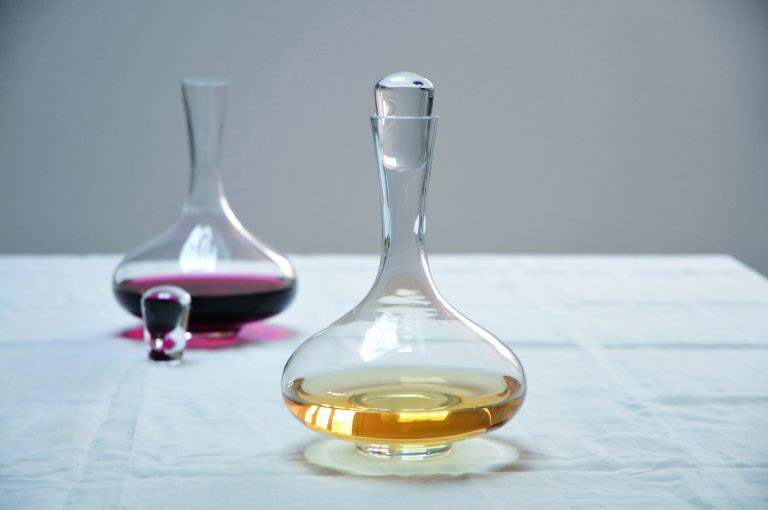
What’s the right order and way to serve wine?
After carrying out all of these preparatory steps, all that remains is to take care of a few final details to serve your wine. Of course, the order in which the wines are served must be carefully considered to ensure that your lucky guests fully appreciate each bottle’s exquisite nectar in beautiful wine tasting glasses.
The order to serve wines
If you are preparing for a wine tasting, feel free to create the wine list of your choice. That being said, one wine naturally leads to another, and the one that is sampled first should not overpower the next in line. It is therefore advisable to serve your younger, lighter, more subtle and delicate wines first, before going on to sample your older, more powerful, richer and more full-bodied wines. An elegant serving tray and a few coasters for wine glasses, for example, will highlight the special care you have taken in preparing this simple wine-tasting ritual, accompanied by light savory or sweet appetizers, depending on the pairings you have chosen.

If you are preparing a wine list for a lunch or dinner, it is customary to serve the white wine before the red wine, but this is not strictly compulsory. The same wine tasting rules should be respected—gradually building up to stronger wines with more complex aromas and a more robust body of tannins—but, above all, your wine selection should be tailored to the food pairings you will be savoring throughout the meal.
Use a pourer
Serving wine with a pourer gives the precise movements mastered by the sommelier an extra touch of elegance and flair. This useful wine tool is positioned on the neck of the bottle to help you avoid losing a drop of wine or staining your beautiful tablecloth. In addition, the wine’s aeration is slightly extended by the graceful and steady stream delivered by the pourer.
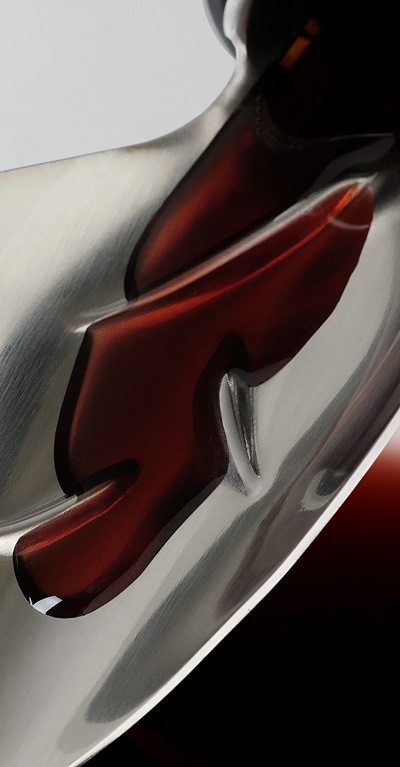
Serve your wine in wine glasses
It goes without saying that if you are sampling a bottle of wine, you should drink from a genuine wine glass, i.e. a long-stemmed, clear glass with a rounded bottom that is wider than the top so that the bouquet of flavors and aromas is concentrated at nose and lip level. When serving, fill each glass of wine about a third full, at most half full, but never more than that.
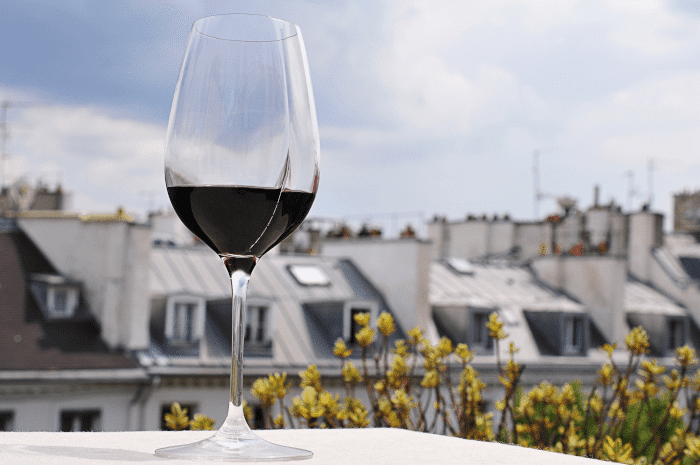
Perfectly suited to the wine-tasting ritual, our unique Exploreur Oenology glass features an Aroma line that sets it apart from the rest. Crafted in glassware, our specialist glass lets your finest vintages dance along its beautiful, curved vein inlaid with beads, revealing all the notes of your exceptional red, white or rosé wines as if by magic. The experience is a truly magical sensation for both the eyes and the palate.
Cover up your bottle for a “blind” wine tasting
For a real oenological challenge or to spice up an evening with fellow fine wine lovers, why not indulge again in a blind tasting? Instead of serving the wine behind closed doors, try L’Atelier du Vin’s handy bottle sleeve to keep the mystery of your vintage hidden until you have poured the last drop. In addition, our famous Wine Quiz will add a fun twist to the evening by testing the oenological knowledge of your friends around the table.
How do you preserve a bottle of wine after serving?
If there is any wine left in the fine bottle you have opened, use a wine stopper after serving to store your wine in a cool place or at room temperature, as needed, until the next meal or the following day. Purists like to use a vacuum pump system to prevent the exquisite nectar inside the bottle from oxidizing. You will experience the benefits at your next tasting!
